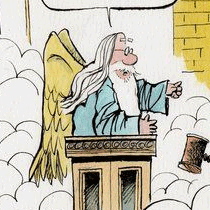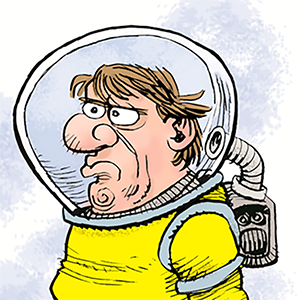Commentary: Cancer partially paralyzed me. Matisse is teaching me how to live a 'second life'
Published in Op Eds
Ten years ago, a radical spine cancer surgery simultaneously saved my life and disabled me.
I had been a very active person, but after surgery, my legs were partially paralyzed. Initially, I leaned on stories of fellow athletes who overcame significant physical handicaps to do their thing again; paralyzed mountain bikers, prosthesis-wearing climbers, blind marathoners, each adapting to achieve milestones in their arenas.
But lately, I draw inspiration from an old man with a round tummy who didn’t get out of bed much. I find myself consumed with the later years of Henri Matisse, an artist his friend and rival Pablo Picasso dubbed “a magician.”
Matisse wasn’t simply vital at the painful, disabled end of his life — he saved the best for last, enjoying the most productive, creative and revolutionary years of his artistic life, despite being mostly sedentary because of complications that made it difficult to stand at his easel.
Matisse’s solution was deceptively simple: reams of painted paper in a range of colors, large tailor’s shears and a dexterous hand.
When the Museum of Modern Art in New York announced a show of Matisse’s cutouts, its curators called the event a “celebration.” All of this work had come during the years after the cancer surgery, a period Matisse called his “second life.” The show is the last time for several years to see his signature “Swimming Pool,” a joyous, room-ringing masterpiece enjoyed by generations and soon to be deinstalled for preservation.
I live in the Boston area, and though I’d seen the cutouts once, many years ago, I felt like I might need to see them again.
Matisse was in his 70s when he had his operation for stomach cancer in 1941. He hoped to get a few more years, he told his doctors. He got 13, working vigorously almost until the day he died in 1954.
His extended cutout period started with a single white swallow, made to cover a stain at his family’s home in Paris. Within days came numerous spirited sea creatures and marine flora, spread across the drab brown walls of multiple rooms. He worked through the night — not unusual given his severe insomnia — asking his nurses to pass him sheets of paper and then, at his direction, to clamber up walls to pin the figures into place.
A few years later, he explained that because his poor health required him to remain often in bed, “I have made a little garden all around me where I can walk. … There are leaves, fruits, a bird.”
He prepared like an athlete. A phalanx of day and night nurses, a masseuse, a homeopath and a team of doctors all helped to make sure Matisse was ready for the next day’s performance. If he couldn’t get out of his wrought iron bed, the bed was moved, using wheels to transport him from room to room.
In December 2014, I drove to New York City with my brother and mother to see the original, much larger exhibition of Matisse’s cutouts at MoMA. It was a family pilgrimage, a kind of tribute to my recently deceased father, a beloved painter and teacher on Massachusetts’ Cape Ann whose colorist works and expressive philosophy was heavily influenced by Matisse. My brothers and I had grown up with Matisse. Our dad’s limited signed print of the cutout “The Flowing Hair,” a variation of the “Blue Nudes” series, hung on our walls.
I was unexpectedly emotional seeing the 100 cutouts. At the time, I was two days from having my radical spine cancer surgery. Through months of radiation, I had been suffering from searing pain and often I would seize up, unable to move a muscle because the slightest twitch was agonizing. In my state, just traveling to the Matisse show was ridiculous, but as I saw his mural seascapes such as “Oceania, the Sea” and his sensuous “Blue Nudes,” I felt a lightness I hadn’t experienced in months.
I expected to fully recover from my surgery. When I didn’t, I began to come back to Matisse. How had he done his uplifting cutouts when he did? How had he expanded his buoyant vision when so many others would lose their way?
When Matisse created his mural-sized “Creole Dancer” in 1950, he wrote to his art dealer son Pierre that he couldn’t bear to sell it to him because he was sure he wouldn’t do something so good again. Instead, he produced many more masterpieces. His ailments slowed him down, but when making his cutouts, he was full speed, likening himself to a juggler or acrobat, the feeling of cutting into bright color akin to flying.
Like Matisse, I now mostly use a wheelchair, and my cancer’s recent activity will require new experimental treatments and more adaptations.
But, as I hoped, seeing his large cutouts in December brought me somewhere else. The magnificent 11-foot-tall, star-showering stained glass window, “Nuit de Noël,” of which I once hung a postcard in my hospital room, was the first work I saw entering the Matisse gallery. And the immersive “Swimming Pool” reminded me how the same balletic scene lifted him as he composed it across his own home walls in Nice. I remembered Matisse’s statement: “Only what I created after my illness constitutes my real self: free, liberated.”
When I left the exhibition, I had an unexpected thought: Maybe you don’t need to be a magician to have a second life.
____
Todd Balf is the author of several books, including “Three Kings: Race, Class and the Barrier-breaking Rivals Who Launched the Modern Olympic Age.”
_____
©2025 Los Angeles Times. Visit at latimes.com. Distributed by Tribune Content Agency, LLC.




























































Comments